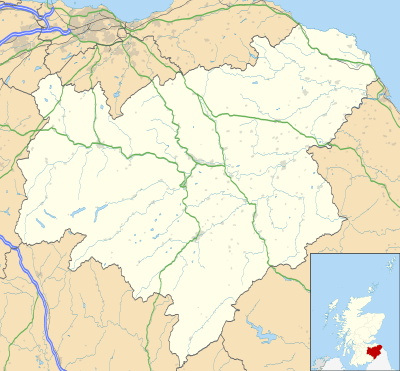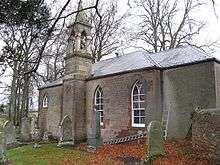Makerstoun
Makerstoun is a parish in the Scottish Borders area of Scotland, as well as the historic county of Roxburghshire, 4 miles (6 km) south-west of Kelso.[1]
Makerstoun
| |
|---|---|
 Makerstoun Location within the Scottish Borders | |
| OS grid reference | NT670324 |
| Council area | |
| Lieutenancy area | |
| Country | Scotland |
| Sovereign state | United Kingdom |
| Post town | Kelso |
| Postcode district | TD5 7 |
| Dialling code | 01573 |
| Police | Scotland |
| Fire | Scottish |
| Ambulance | Scottish |
| UK Parliament | |
| Scottish Parliament | |
The parish lies north of the river Tweed [2]), which forms the southern boundary of the parish. It is bounded on the west by the parish of Mertoun in Berwickshire, on the north by the parish of Smailholm, on the east by the parish of Kelso and on the south by the parish of Roxburgh, from which it is separated by the River Tweed.[2]
The name of the parish reputedly means the town of Machar.[2]
For many centuries most of the land in the parish has been owned by the proprietor of Makerstoun estate, thus in the 19th century most of the land belonged to Sir Thomas Makdougall Brisbane of Makerstoun House (former Governor of New South Wales).[2]
Formerly, the greater part of the population was extremely fluctuating. All the families, except a few (nine in 1845), being the families either of farm servants or of tradesmen employed by the farmers, were liable to be removed every year.[2] However, as the small farmers were dispensed with by the landlords, the population reduced from over 1,000 at the end of 18th century to 132 in 1981.[3]

The area of the parish is 2,865 acres (1,160 ha).[1]
The original medieval church was sited in the grounds of Makerstoun House (thus in the south of the parish near the Tweed), where some remains still exist.[4] The first recorded minister of the church dates from 1567. In 1807 it was decided by the Makerstoun estate that the church, and the manse with its offices and garden should be moved to a more central site in the parish.[5] A new church was thus built in 1808, which stands to the present day.[5]
The Community Council for Makerston is the Floors, Makerstoun, Nenthorn and Smailholm Community Council,[6][7] which covers the parishes of Makerstoun and Smailholm in Roxburghshire , the parish of Nenthorn in Berwickshire and Floors Castle. It has 12 members, two of whom (as of 2015) were the Laird of Makerstoun and his wife.[7]
Barony of Makerstoun
The barony in later medieval Scotland was a very common franchise, increasingly defined as an estate to which specific ‘baronial’ powers attached. In general the barons had essentially the same criminal and civil jurisdiction within their barony as the sheriffs had within the sheriffdom. Commonly the baronies coincided with the parishes and were anyway roughly parish sized. Makerstoun, like 18 other baronies in Roxburghshire (Bedrule, Cavers, Ednam, Hownam, Linton, Longnewton, Maxton, Maxwell, Minto, Smailholm, Wilton, and Yetholm) corresponded exactly or closely with the eponymous parish.[8] The earliest proprietor of the Barony of Makerstoun named in the records is Walter Corbet, who acquired the barony about the middle of the 12th century.[9] About 1125, Walter Corbet, Laird of Makerstoun, built the village of Makerstoun and the church, St. Peter’s.[5] His father was Robert Corbet, who came from Shropshire in the beginning of the 12th century, and settled in Teviotdale under Earl David (later King David I of Scotland).[9] A small fortified keep known as a pele tower was built at Makerstoun in 1128. The tower was extended in 1300.[10]
In 1374 Robert II confirmed Fergus MacDowall as baron of Makerstoun, which he had inherited from the Corbet family via his mother Margaret.[11] This was the first baron of the MacDowall, also known as MacDougall, family (various spellings used for both). About 1390, Archibald McDowell got a grant from Robert III of the lands of “M'Carstoune”, Yetholm, and Elistone (Clifton).[9] The tower was rebuilt by Thomas Makdowell in 1590.
By a settlement made by Henry Makdougall, 14th baron of Makerstoun, in 1715, the barony was infeft to his daughter Barbara Makdougall in 1723. She married Sir George Hay (later Hay-Makdougall), and the Makerstoun estate passed to the Hay-Makdougall family[11]
Makerstoun House
Makerstoun House, a square three storey building, is situated on the north bank of the Tweed, in the south of the parish, and stands in grounds (about 100 acres (40 ha)) that are extensive and well wooded.[12]
The medieval house, originally a keep, was destroyed in Hertford's invasion of Scotland of 1545. A mansion was rebuilt in 1590 on the foundations of this house. The East end with a first floor vaulted chamber may be the oldest part, a pele tower, to which in the 15th century a wing was added on the West.[4]
From 1714 to 1725 the house was extended on plans by William Adam, (father to Robert Adam the architect who created Edinburgh New Town).[10] In 1828 further additions were made, including castellations.
Makerstoun House was rebuilt after a fire in 1973 using William Adam’s plans of 1714-21, without castellation.[3]
The burial ground of the Macdougall family is situated close to Makerstoun House.[4] House and grounds contain a number of 18th and 19th century monuments, including that to Sir Thomas Makdougall Brisbane, Governor of New South Wales (d.1860).[4]
The current owner is Baron Biddulph, of Ledbury in the County of Hereford.[10]
References
- Survey Gazetteer of the British Isles, publ. J.G. Bartholomew, 1904, p. 535
- New Statistical Account of Scotland, Vol III Roxburgh, Peebles, Selkirk, publ.William Blackwood, 1845, pp.235-240. (Makerstoun article by Rev.David Hogarth, Minister of Makerstoun, 1834)
- The MacDowalls, by Fegus Macdowall and William MacDougall, publ.by Clan MacDougall Society of North America, 2009, p.35
- Official web site of the government agency Historic Scotland http://portal.historic-scotland.gov.uk/designation/LB19734 retrieved Feb 2016
- Church of Scotland web site: http://www.kelsolinkedchurchescofs.org/makerstoun retrieved Feb 2014
- Community Council entry on Scottish Borders local authority web site; http://www.scotborders.gov.uk/directory_record/7704/floors_makerstoun_nenthorn_and_smailholm retrieved Feb 2016
- Smailholm village web site has news on their common Community Council: "Archived copy". Archived from the original on 4 April 2012. Retrieved 11 February 2016.CS1 maint: archived copy as title (link) retrieved Feb 2016
- Liberties and Identities in the Medieval British Isles, ed. M. Prestwich, Boydell Press, 2008. Chapter 9 Franchises North of the Border: Baronies and Regalties of Medieval Scotland, by Alexander Grant, p 155 et seq
- The History and Antiquities of Roxburghshire and Adjacent Districts , by Alexander Jeffrey,publ. Edinburgh, 1859
- Makerstoun House web site: http://www.makerstoun.com/history.htm retrieved Feb 2016
- Genealogical and Heraldic History of The Commoners of Great Britain and Ireland, Enjoying Territorial Possessions or High Official Rank;but Uninvested With Heritable Honours. By John Burke, pub. London 1836, Vol III, pp.430-436
- Ordnance Gazetteer of Scotland, by, Francis Groome, publ. 1882-4. Article on Makerstoun